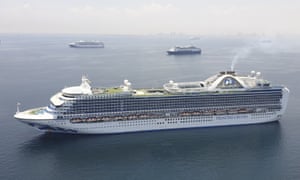From the balcony of her cabin, Sofia Ivanov* welcomes the light rain that cools the scorching Manila summer. As coronavirus empties the world’s cruise lines of guests, crew workers like her get to use the luxurious guest rooms before they lose their jobs.
Over two dozen other massive cruise ships dot her view of Manila Bay. It’s a spectacular view, but Ivanov is tired of it after seeing nothing else for weeks.
She expected to disembark and catch a flight home to Russia soon after her ship arrived on 6 May, but she’s still stranded with thousands of other crew three weeks later.
“A lot of ships are stuck here. There are a lot of Costa ships. Princess as well,” says Ivanov, referring to the biggest cruise lines operators.
Before the pandemic, the vessels would have been welcomed for the dollars their passengers brought. These days, the ships only bring potential coronavirus carriers.
Two of the most notorious ships, the Diamond Princess and Ruby Princess, are among the fleet in Manila Bay.
They’ve been turned away by other countries but the Philippines, which provides most of the world’s maritime workers, allowed them to dock and disembark its citizens.
But the scale overwhelmed the government, which was testing not just returning cruise ship crews but tens of thousands of other overseas workers who arrived in airports.
“We have to regulate the entry. We test them … and make sure they’re negative for the virus before we send them home to their families,” says Restituto Padilla, spokesperson for the National Task Force Against Covid-19.
The test is supposed to take an average of three days in a country notorious for its poor testing capacity. But 7,000 Filipino crew in Manila Bay waited days or weeks just for government teams to board their ships and take their samples.
It took even longer for the results to come back . Government spokespeople say there’s a lot of backlog because there are not enough encoders. Crew were told their results were misplaced due name mix-ups and misspellings.

Foreigners like Ivanov, who are allowed to disembark provided they fly out of the country immediately, can’t understand why they’re being held up, too.
“There is nothing to do here apart from using the slowest ever Internet and walking around deserted open areas after meals. No wonder that some people commit suicides,” Ivanov says, referring to incidents in other countries.
Experts estimate there are up to 200,000 people stuck at sea worldwide. Getting them safely off their ships is an urgent situation, says Kitack Lim, secretary-general of the International Maritime Organization (IMO).
Ivanov, at least, can move around the ship. The Filipino crew have been made to isolate inside their cabins.
Filipinos, so near yet so far from their homes, have been generally patient. If they’re not speaking to families in video calls, they are spending their time posting selfies from their rooms or videos of the massive ships blowing their horns.
There are those who have enjoyed the forced vacation. But homesickness hit others hard. A couple who worked in the same cruise ship was separated in quarantine. They could only see each other from their balconies, while their son waited for them at home.
As the days passed, even the cheeriest Filipino ran low on patience and their social media posts grew desperate by the day. “We are not asking for a red carpet repatriation process. We asked for better, seamless, and fast repatriation,” says Kevin Reyes* who waited 38 days to disembark.
On 25 May, as complaints poured in, president Rodrigo Duterte intervened and ordered officials to speed up the process. Within days, hundreds of crew magically received their results online.
The crew’s latest live videos on Facebook show them cheering as they disembark.
Government data is so disorganised that it cannot provide separate results for cruise ship crews. But more than 400 returning overseas workers have tested positive for coronavirus. Padilla said most of the virus carriers among the crew workers didn’t show symptoms.
Most of the stranded crew have finally disembarked. Ivanov isn’t among them yet. As of 29 May, she was still stranded with over 2,000 Filipino crew.
A few cruise ships have begun to leave Manila Bay. But several others are just arriving.
Additional reporting by Patrick Greenfield.
*Names of workers have been changed